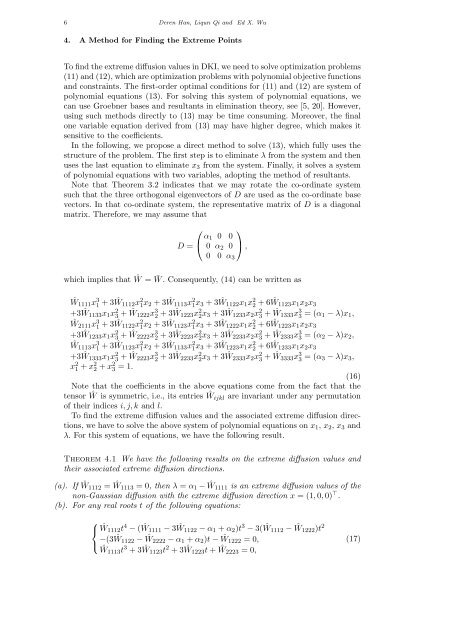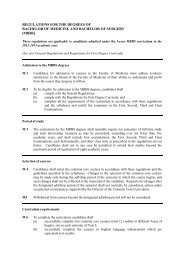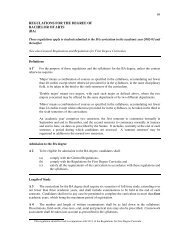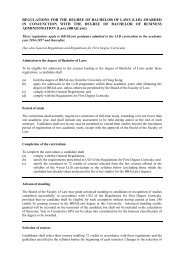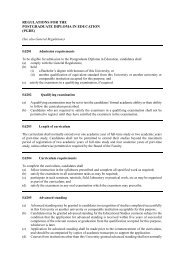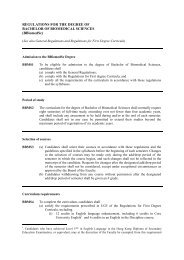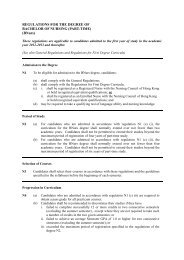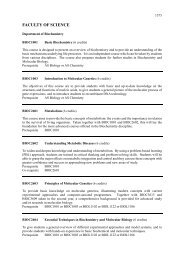RESEARCH ARTICLE Extreme Diffusion Values for non-Gaussian ...
RESEARCH ARTICLE Extreme Diffusion Values for non-Gaussian ...
RESEARCH ARTICLE Extreme Diffusion Values for non-Gaussian ...
Create successful ePaper yourself
Turn your PDF publications into a flip-book with our unique Google optimized e-Paper software.
6 Deren Han, Liqun Qi and Ed X. Wu<br />
4. A Method <strong>for</strong> Finding the <strong>Extreme</strong> Points<br />
To find the extreme diffusion values in DKI, we need to solve optimization problems<br />
(11) and (12), which are optimization problems with polynomial objective functions<br />
and constraints. The first-order optimal conditions <strong>for</strong> (11) and (12) are system of<br />
polynomial equations (13). For solving this system of polynomial equations, we<br />
can use Groebner bases and resultants in elimination theory, see [5, 20]. However,<br />
using such methods directly to (13) may be time consuming. Moreover, the final<br />
one variable equation derived from (13) may have higher degree, which makes it<br />
sensitive to the coefficients.<br />
In the following, we propose a direct method to solve (13), which fully uses the<br />
structure of the problem. The first step is to eliminate λ from the system and then<br />
uses the last equation to eliminate x 3 from the system. Finally, it solves a system<br />
of polynomial equations with two variables, adopting the method of resultants.<br />
Note that Theorem 3.2 indicates that we may rotate the co-ordinate system<br />
such that the three orthogonal eigenvectors of D are used as the co-ordinate base<br />
vectors. In that co-ordinate system, the representative matrix of D is a diagonal<br />
matrix. There<strong>for</strong>e, we may assume that<br />
D =<br />
⎛<br />
⎝ α ⎞<br />
1 0 0<br />
0 α 2 0 ⎠ ,<br />
0 0 α 3<br />
which implies that Ŵ = ¯W . Consequently, (14) can be written as<br />
Ŵ 1111 x 3 1 + 3Ŵ1112x 2 1 x 2 + 3Ŵ1113x 2 1 x 3 + 3Ŵ1122x 1 x 2 2 + 6Ŵ1123x 1 x 2 x 3<br />
+3Ŵ1133x 1 x 2 3 + Ŵ1222x 3 2 + 3Ŵ1223x 2 2 x 3 + 3Ŵ1233x 2 x 2 3 + Ŵ1333x 3 3 = (α 1 − λ)x 1 ,<br />
Ŵ 2111 x 3 1 + 3Ŵ1122x 2 1 x 2 + 3Ŵ1123x 2 1 x 3 + 3Ŵ1222x 1 x 2 2 + 6Ŵ1223x 1 x 2 x 3<br />
+3Ŵ1233x 1 x 2 3 + Ŵ2222x 3 2 + 3Ŵ2223x 2 2 x 3 + 3Ŵ2233x 2 x 2 3 + Ŵ2333x 3 3 = (α 2 − λ)x 2 ,<br />
Ŵ 1113 x 3 1 + 3Ŵ1123x 2 1 x 2 + 3Ŵ1133x 2 1 x 3 + 3Ŵ1223x 1 x 2 2 + 6Ŵ1233x 1 x 2 x 3<br />
+3Ŵ1333x 1 x 2 3 + Ŵ2223x 3 2 + 3Ŵ2233x 2 2 x 3 + 3Ŵ2333x 2 x 2 3 + Ŵ3333x 3 3 = (α 3 − λ)x 3 ,<br />
x 2 1 + x2 2 + x2 3 = 1. (16)<br />
Note that the coefficients in the above equations come from the fact that the<br />
tensor Ŵ is symmetric, i.e., its entries Ŵijkl are invariant under any permutation<br />
of their indices i, j, k and l.<br />
To find the extreme diffusion values and the associated extreme diffusion directions,<br />
we have to solve the above system of polynomial equations on x 1 , x 2 , x 3 and<br />
λ. For this system of equations, we have the following result.<br />
Theorem 4.1 We have the following results on the extreme diffusion values and<br />
their associated extreme diffusion directions.<br />
(a). If Ŵ 1112 = Ŵ1113 = 0, then λ = α 1 − Ŵ1111 is an extreme diffusion values of the<br />
<strong>non</strong>-<strong>Gaussian</strong> diffusion with the extreme diffusion direction x = (1, 0, 0) ⊤ .<br />
(b). For any real roots t of the following equations:<br />
⎧<br />
⎨ Ŵ 1112 t 4 − (Ŵ1111 − 3Ŵ1122 − α 1 + α 2 )t 3 − 3(Ŵ1112 − Ŵ1222)t 2<br />
−(3Ŵ1122 −<br />
⎩<br />
Ŵ2222 − α 1 + α 2 )t − Ŵ1222 = 0,<br />
Ŵ 1113 t 3 + 3Ŵ1123t 2 + 3Ŵ1223t + Ŵ2223 = 0,<br />
(17)


